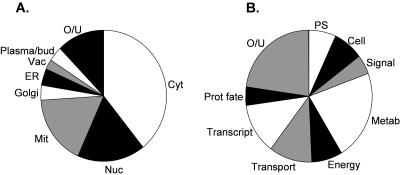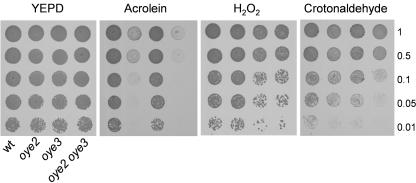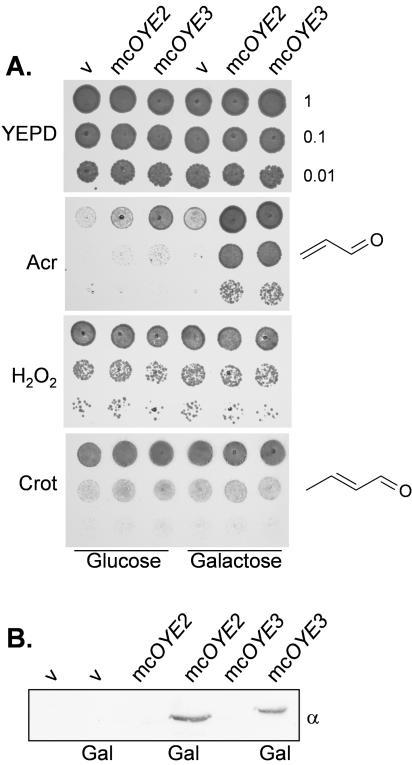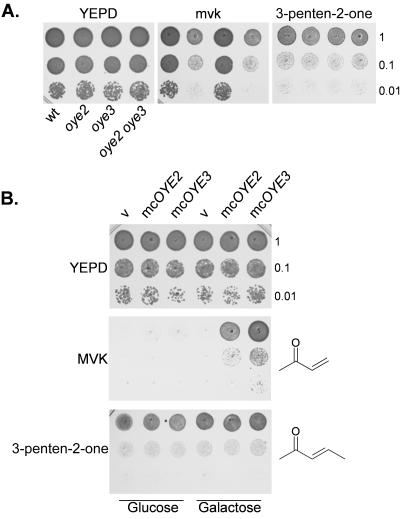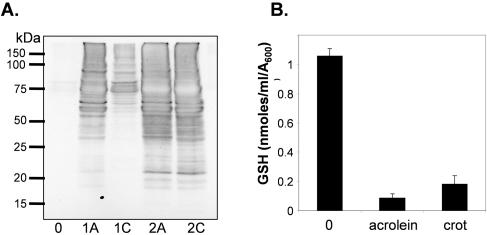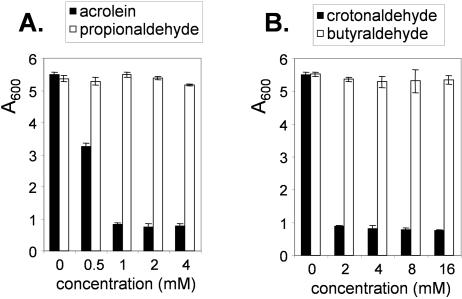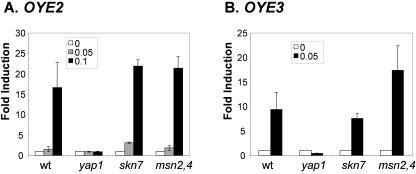Abstract
Acrolein is a ubiquitous reactive aldehyde which is formed as a product of lipid peroxidation in biological systems. In this present study, we screened the complete set of viable deletion strains in Saccharomyces cerevisiae for sensitivity to acrolein to identify cell functions involved in resistance to reactive aldehydes. We identified 128 mutants whose gene products are localized throughout the cell. Acrolein-sensitive mutants were distributed among most major biological processes but particularly affected gene expression, metabolism, and cellular signaling. Surprisingly, the screen did not identify any antioxidants or similar stress-protective molecules, indicating that acrolein toxicity may not be mediated via reactive oxygen species. Most strikingly, a mutant lacking an old yellow enzyme (OYE2) was identified as being acrolein sensitive. Old yellow enzymes are known to reduce α,β-unsaturated carbonyl compounds in vitro, but their physiological roles have remained uncertain. We show that mutants lacking OYE2, but not OYE3, are sensitive to acrolein, and overexpression of both isoenzymes increases acrolein tolerance. Our data indicate that OYE2 is required for basal levels of tolerance, whereas OYE3 expression is particularly induced following acrolein stress. Despite the range of α,β-unsaturated carbonyl compounds that have been identified as substrates of old yellow enzymes in vitro, we show that old yellow enzymes specifically mediate resistance to small α,β-unsaturated carbonyl compounds, such as acrolein, in vivo.
All aerobic organisms are exposed to reactive oxygen species (ROS), such as H2O2, the superoxide anion, and the hydroxyl radical, during the course of normal aerobic metabolism or following exposure to radical-generating compounds in the environment (19). Unsaturated lipids are major targets of ROS attack, resulting in lipid peroxidation. During lipid peroxidation, reactive lipid and fatty acid radicals are formed, which can attack other fatty acids, leading to oxidative chain reactions. These chain reactions proceed until they come into contact with a chain-breaking antioxidant, such as vitamin E. As a result of the oxidative damage to lipids, various lipid hydroperoxides are formed. These are relatively unstable and are converted into breakdown products which can be just as toxic as the ROS themselves (4). Major breakdown products include reactive aldehydes, such as malondialdehyde (MDA) and acrolein. These reactive aldehydes have a number of cytotoxic effects and inhibit a variety of enzymes. For example, they have been shown to cause membrane damage by increasing fluidity (2, 5), to damage DNA (37), and to interact with high- and low-density lipoprotein, which contributes to atherosclerosis (17). In addition, they can react with nucleophiles, such as the sulfhydryl group of cysteine (5, 32). Not surprisingly, therefore, reactive aldehydes are highly toxic.
We have previously shown that yeast cells are sensitive to the model lipid hydroperoxide, linoleic acid hydroperoxide (LoaOOH), when added exogenously (6). LoaOOH is toxic to yeast at very low concentrations compared to H2O2 and other organic peroxides. The roles of known antioxidant defense mechanisms in protection against LoaOOH have been examined, and strains lacking the Yap1 transcriptional activator protein or defective in glutathione (GSH) metabolism are hypersensitive to this oxidant (6). MDA is a three-carbon dialdehyde which has been extensively used as a measure of lipid peroxidation (15, 20). Low intracellular levels of MDA (0.1 mM) are detected in unstressed yeast cells, and these levels are elevated approximately fivefold in response to treatment with H2O2 (31). Yeast cells are sensitive to MDA, and similar to LoaOOH, Yap1 and GSH are required for maximal resistance (31).
Eukaryotic cells can adapt to oxidative stress conditions, becoming more resistant to a subsequent high dose following exposure to a low, nonlethal dose of a particular ROS (28). Adaptation depends on gene activation and de novo protein synthesis, typically altering global gene expression programs, including genes encoding antioxidants and other protective molecules (1, 8). ROS treatment of yeast causes some cross-adaptation whereby prior exposure to one ROS increases resistance to another. Comparing patterns of cross-adaptation has helped in understanding the damage elicited by different ROS and reactive molecules (28). For example, yeast cells can mount a Yap1-dependent adaptive response to both LoaOOH (6) and MDA (31). However, pretreatment with MDA increases resistance to LoaOOH, whereas LoaOOH does not promote cross-resistance to MDA (6). These data indicate that different defense systems may be required to detoxify or repair the damage resulting from lipid peroxidation. The aim of this current study was to identify the gene products which are required for resistance to the reactive aldehyde acrolein.
Acrolein (CH2=CH—CHO) is a ubiquitous environmental pollutant which is formed during the incomplete combustion of petrol, coal, wood, and plastics as well as from cigarette smoke (5, 32). It is also formed during the biotransformation of allyl compounds and the widely used anticancer drug cyclophosphamide. Acrolein has been identified as a product of lipid peroxidation in biological systems (32). Among the α,β-unsaturated aldehydes, acrolein is by far the strongest electrophile, reacting with nucleophiles, such as the sulfhydryl group of cysteine, the imidazole group of histidine, and the amino group of lysine (5, 32). Not surprisingly, therefore, acrolein is highly toxic towards mammalian cells and is a potent mutagen (5). Despite our understanding of the molecular effects underlying the toxicity of acrolein, relatively little is known regarding the cellular systems which protect against acrolein and other reactive aldehydes. We have performed a genome-wide screen to identify mutants which are sensitive to acrolein in order to identify the protective systems that serve to detoxify reactive aldehydes. This analysis shows that a wide range of gene functions is required to protect against acrolein stress. In particular, we show that old yellow enzyme 2 (Oye2), which is a widely conserved NADPH-dependent oxidoreductase, is required for acrolein tolerance.
MATERIALS AND METHODS
Yeast strains and plasmids.
The Saccharomyces cerevisiae strains used in this study were isogenic derivatives of CY4 (MATa ura3-52 leu2-3 leu2-112 trp1-1 ade2-1 his3-11 can1-10) (11). Strains deleted for YAP1, SKN7, and MSN2-MSN4 have been described previously (9, 10, 24). The oye2 and oye3 deletion strains were made by back-crossing CY4 with EUROSCARF deletion strains (oye2::KanMX and oye3::KanMX). Standard yeast genetic techniques were used to construct mutants lacking both OYE2 and OYE3. Overexpression plasmids were constructed using the Invitrogen pYES/CT plasmid by cloning PCR-generated fragments of OYE2 and OYE3 in frame with the V5 epitope tag and downstream of the GAL1 promoter.
Growth conditions.
Strains were grown in rich YEPD medium (2% [wt/vol] glucose, 2% [wt/vol] Bacto Peptone, 1% [wt/vol] yeast extract) or minimal SD medium (0.17% [wt/vol] yeast nitrogen base without amino acids, 5% [wt/vol] ammonium sulfate, 2% [wt/vol] glucose) supplemented with appropriate amino acids and bases (26) at 30°C and with shaking at 180 rpm. Media were solidified by the addition of 2% (wt/vol) agar. Stress sensitivity was determined by growing cells to stationary phase and spotting them onto agar plates containing various concentrations of the chemicals to be tested. Strains containing plasmid pYES/CT::OYE2 or pYES/CT::OYE3 were grown to exponential phase in minimal media containing glucose and then grown for 6 h in minimal media containing 2% (wt/vol) glucose or 2% (wt/vol) galactose, prior to testing of stress sensitivity.
Genome-wide screening for mutations causing sensitivity to acrolein.
The S. cerevisiae strains used in this study were derivatives of BY4743 (MATa/α his3Δ1/his3Δ1 leu2Δ0/leu2Δ0 met15Δ0/MET15 lys2Δ0/LYS2 ura3Δ0/ura3Δ0), which are homozygous for the relevant gene deletion. The construction of the yeast genome deletion library has been described previously (36). Cells were grown to stationary phase in YEPD medium in static 96-well plates. Following resuspension, cells were diluted 1/10 and plated onto YEPD plates containing 5 mM acrolein using a 96-pin replicator. Plates were incubated at 30°C for 3 to 4 days before scoring of growth. Mutant sensitivity was confirmed by picking mutants and retesting them for acrolein sensitivity.
Western blot analysis.
Protein extracts were electrophoresed under reducing conditions on 10% sodium dodecyl sulfate-polyacrylamide gel electrophoresis gels and electroblotted onto polyvinylidene difluoride membrane (Amersham Pharmacia Biotech), and bound antibody was visualized by chemiluminescence (ECL kit; Amersham Pharmacia Biotech). Old yellow enzyme levels were detected using mouse anti-V5 (1:5,000 dilution) (Invitrogen) and sheep anti-mouse immunoglobulin-horseradish peroxidase conjugate (1:2,000 dilution) (Amersham Pharmacia Biotech). Carbonylation of protein was measured by reacting carbonyl groups with 2,4-dinitrophenylhydrazine (DNPH) as described previously (25). Carbonylation was detected using rabbit anti-DNPH (1:2,000 dilution) (Dako) and donkey anti-rabbit immunoglobulin-horseradish peroxidase conjugate (1:5,000 dilution) (Amersham Pharmacia Biotech).
Glutathione assays.
Total glutathione levels were determined as described previously (13).
RT-PCR.
Cells were grown in minimal media to exponential phase and treated as described below (see “Regulation of OYE2 and OYE3 expression in response to acrolein stress”) before extraction of RNA using an RNeasy kit (QIAGEN). Reverse transcription (RT)-PCR was carried out using an iScript one-step RT-PCR kit with SYBR green (Bio-Rad) according to the manufacturer's instructions and using a Bio-Rad iCycler and MyiQ single-color real-time PCR detection system.
RESULTS
Identification of acrolein-sensitive strains.
The homozygous diploid deletion mutant collection was screened to identify nonessential gene products that are required for resistance to acrolein. Strains were grown in YEPD media in microtiter plates and spotted onto YEPD plates containing 5 mM acrolein. This concentration of acrolein was chosen since it allowed for normal growth of the wild-type strain but prevented growth of sensitive mutants. The screen identified 128 mutants which are reproducibly sensitive to acrolein (Table 1).
TABLE 1.
Genes required for acrolein resistance
| Process | Genes/ORFs |
|---|---|
| Protein synthesis | PET130, RML2, MRPL49, MSF1, NAM2, RSM28, RPL22A, RPP1A, RPL21A |
| Cell cycle and DNA processing | IWR1, PIF1, MHR1, PGD1, HOS4, GLO3, CIN1, SLX8, RFM1, NEJ1 |
| Cellular communication/signal transduction | LSB1, ROM2, RHO2, SLT2, MKK1, GIS4 |
| Metabolism | |
| Amino acid | FSH3, TRP3, HOM6, CYS3, ARO1, DPH5 |
| Lipid | ERG5, ERG6, ERG24, CRD1, BTS1, KCS1, CAX4, SFK1 |
| Nitrogen | URE2, RMA1, YLL057C |
| Nucleotide | DBR1, ADE1 |
| Carbon | BEM4, FKS1, MNN10, GSC2, DAK1, GND1, RPE1, ALD2, ACF2 |
| Energy | COX6, QCR7, COX12, ATP7, CYT1, COX10, COQ6, OYE2, MAM33, SLS1 |
| Cellular transport | PET8, OAC1, LUV1, SEC22, VPS33, SAC1, VMA13, VMA2, COG5, COG1, NUP84, VMA10, BAP2, PHO88 |
| Transcription | EDS1, PET54, PET309, SWI3, SNF6, SNF2, SNF5, SRB5, MAC1, GAL11, YAP1, STB5, PAF1, WTM1, EMI1, RAI1 |
| Protein fate (folding, modification, destination) | YME1, VMA21, YTA7, MEH1, BRE1, MON2, |
| Miscellaneous/unclassified | KRE26, KRE25, KRE27, CGI121, APQ13, MMM1, BUD22, OPY1, LOT6, YJL120W, YNL226W, YNL170W, YML030W, YKL037W, YKL118W, YKL050C, YLR143W, YLR232W, YLR241W, YLR257W, YPL071C, YPR123C, YLR280C, YHR177W, YHR100C, YOR114W, YDL186W, YDL187C, YMR173W-A |
Aldehyde stress has been studied primarily as a product of lipid peroxidation. However, grouping the gene products according to their cellular components revealed that acrolein-sensitive mutants are not associated with any particular organelle and are localized throughout the cell (Fig. 1A). Gene products are localized mainly to the cytoplasm, mitochondria, and nucleus. In addition, gene products are localized throughout the secretory pathway, including in the endoplasmic reticulum, Golgi, vacuole, and plasma membranes. Gene products were grouped into functional categories according to the MIPS functional database (http://mips.gsf.de/genre/proj/yeast/index.jsp) and the Saccharomyces Genome Database GO term mapper (http://db.yeastgenome.org/cgi-bin/SGD/GO/goTermMapper). Acrolein-sensitive mutants are distributed among most major biological processes but particularly those of gene expression (transcription), metabolism, and cellular signaling (Fig. 1B and Table 1).
FIG. 1.
Functional grouping of deletion mutant sensitivity data. (A) Localization was assigned based on the “Component” term of the Saccharomyces Genome Database GO term mapper. Cyt, cytoplasm; Nuc, nucleus; Mit, mitochondrion; Golgi, Golgi apparatus; ER, endoplasmic reticulum; Vac, vacuole; Plasma/bud, plasma membrane and bud; O/U, other/unknown. (B) Gene products were grouped into functional categories according to the MIPS functional database and the Saccharomyces Genome Database, combined with visual inspection. More-detailed functional data are available in Table 1. PS, protein synthesis; Cell, cell cycle and differentiation; Signal, cellular communication/signal transduction; Metab, metabolism; Transport, cellular transport; Transcript, transcription; Prot fate, protein fate; O/U, other/unknown.
Surprisingly, the screen did not identify any antioxidants or similar stress-protective molecules. Similarly, it did not identify any components of the redox regulatory systems, including the glutathione system. We have directly examined the role of GSH in protection against acrolein and found that mutants lacking components of the glutathione system are unaffected in acrolein sensitivity (our unpublished data). This is particularly surprising given the well-characterized role of GSH in protection against electrophilic compounds, such as acrolein. Interestingly, a mutant lacking an old yellow enzyme (OYE2) was identified as being acrolein sensitive (Table 1). Old yellow enzymes were originally identified as flavin-dependent oxidoreductases, but despite extensive characterization, their physiological role has remained uncertain (35). Many electron acceptors have been identified for old yellow enzymes, including α,β-unsaturated carbonyl compounds (33), and hence, Oye2 was chosen for further analysis.
Mutants lacking OYE2 are sensitive to acrolein stress.
Yeast contains two homologous genes, OYE2 and OYE3, encoding old yellow enzymes. Isogenic haploid strains lacking OYE2 or OYE3 were constructed in order to test their sensitivities to acrolein. In agreement with the deletion screen, the oye2 mutant was sensitive and showed poor growth on plates containing 3 mM acrolein (Fig. 2). In contrast, loss of OYE3 did not affect acrolein tolerance. Deletion of OYE3 in the oye2 mutant strain resulted in a slight increase in acrolein sensitivity, suggesting that OYE3 may protect against acrolein stress in the absence of OYE2. Loss of OYE2 did not affect sensitivity to hydrogen peroxide, whereas there was a moderate increase in sensitivity to H2O2 in the oye3 and oye2 oye3 mutant strains (Fig. 2). Similarly, the oye3 and oye2 oye3 mutant strains were sensitive to other hydroperoxides, including cumene hydroperoxide and tert-butyl hydroperoxide, whereas the oye2 mutant showed a wild-type level of resistance (data not shown).
FIG. 2.
Deletion of OYE2 causes sensitivity to acrolein. Sensitivity was determined by spotting strains on YEPD plates containing various concentrations of acrolein, H2O2, or crotonaldehyde. Cultures of wild-type (wt), oye2, oye3, and oye2 oye3 cells were grown to stationary phase and the A600 was adjusted to 1, 0.5, 0.1, 0.05, or 0.01 before the cells were spotted onto plates. Growth was monitored after 3 days of incubation at 30°C. Results are shown for plates containing no oxidant (YEPD), 3 mM acrolein, 4 mM H2O2, and 2 mM crotonaldehyde.
To further examine the role of old yellow enzymes, we tested whether overexpression of OYE2 or OYE3 could increase resistance to acrolein or ROS. OYE2 and OYE3 overexpression were achieved using the GAL1 promoter on a multicopy plasmid and were confirmed by Western blot analysis (Fig. 3B). Overexpression of either OYE2 or OYE3 was found to markedly increase resistance to acrolein compared to that of the vector or glucose-grown controls (Fig. 3A). In contrast, there was no increase in resistance to hydroperoxides (Fig. 3A and data not shown). Taken together, these data indicate that OYE2 and OYE3 mediate acrolein tolerance but play a limited role in protection against ROS.
FIG. 3.
Overexpression of OYE2 or OYE3 increases resistance to acrolein. (A) Wild-type strains containing empty vector pYES/CT (v) or vector-containing OYE2 (mcOYE2) or OYE3 (mcOYE3) were grown to exponential phase in minimal SD media. Cells were washed and resuspended in minimal media containing glucose or galactose (Gal) to induce the expression of OYE2 and OYE3. Cultures were adjusted to A600 values of 1, 0.1, and 0.01 before being spotted onto plates. Results are shown for plates containing no oxidant (YEPD), 4 mM acrolein, 4 mM H2O2, and 2.5 mM crotonaldehyde (Crot). Chemical structures are shown for acrolein (Acr) and crotonaldehyde. (B) Overexpression of OYE2 and OYE3 was confirmed by means of Western blot analysis.
Old yellow enzymes do not protect against other aldehydes.
Mutant strains were tested for sensitivity to a range of aldehydes in order to determine whether old yellow enzymes can detoxify aldehydes other than acrolein. Loss of OYE2 or OYE3 did not affect sensitivity to crotonaldehyde (Fig. 2). Similarly, old yellow enzyme mutants were unaffected in sensitivity to acetaldehyde, hexenal, or formaldehyde (data not shown). In addition, overexpression of OYE2 or OYE3 did not increase resistance to crotonaldehyde (Fig. 3A) or other aldehydes (data not shown). These results are surprising since a previous study has shown that old yellow enzyme can reduce both acrolein and crotonaldehyde in vitro (33). This previous study showed that old yellow enzyme purified from brewer's bottom yeast can reduce acrolein and crotonaldehyde at similar rates (turnover numbers of 170 and 150 min−1, respectively). In order to understand this apparent difference in substrate specificity between in vitro and in vivo experiments, we determined whether OYE2 or OYE3 can mediate resistance to other α, β-unsaturated compounds.
Old yellow enzymes specifically mediate resistance to small α,β-unsaturated compounds.
In vitro enzyme analysis has shown that old yellow enzymes can reduce the α,β-unsaturated ketones methyl vinyl ketone (MVK) and 3-penten-2-one with turnover numbers of 170 and 96 min−1, respectively (33). We therefore examined the sensitivities of strains lacking or overexpressing old yellow enzymes to MVK and 3-penten-2-one. Similar to the pattern seen with acrolein, deletion of OYE2 caused sensitivity to MVK, and overexpression of both OYE2 and OYE3 increased resistance to MVK (Fig. 4). In contrast, loss or overexpression of OYE2 or OYE3 did not affect cellular resistance to 3-penten-2-one (Fig. 4). Acrolein and MVK are the smallest of the α,β-unsaturated aldehydes and ketones, respectively, while crotonaldehyde and 3-penten-2-one are extended by one methyl group at the β carbon (compare the chemical structures shown in Fig. 3A and 4B). It is possible that the increased sizes of crotonaldehyde and 3-penten-2-one account for the inability of old yellow enzymes to detoxify these compounds in vivo. However, the increased sizes of crotonaldehyde and 3-penten-2-one also lead to decreases in solubility compared to those of acrolein and MVK. It is therefore possible that acrolein and MVK can move more freely into cells but that crotonaldehyde and 3-penten-2-one may not fully penetrate cell membranes, making them inaccessible to Oye2 and Oye3. To test this possibility, we examined whether acrolein and crotonaldehyde elicit similar patterns of cellular damage.
FIG. 4.
Old yellow enzymes promote resistance to methyl vinyl ketone but not to 3-penten-2-one. (A) Cultures of wild-type (wt), oye2, oye3, and oye2 oye3 cells were grown to stationary phase and the A600 was adjusted to 1, 0.1, or 0.01 before the cells were spotted onto plates containing MVK or 3-penten-2-one. Growth was monitored for 3 days, and results are shown for 1 mM MVK and 1.5 mM 3-penten-2-one. (B) Overexpression of OYE2 or OYE3 increases resistance to MVK but not to 3-penten-2-one. Wild-type strains containing vector (v), mcOYE2, or mcOYE3 were tested for sensitivity to MVK or 3-penten-2-one as described for Fig. 3. Chemical structures are shown for MVK and 3-penten-2-one.
Protein carbonylation is a widely used measure of protein oxidative damage (23). Carbonyl groups on proteins can be detected by Western blot analysis using an antibody against the carbonyl-specific probe DNPH. Exposure to both acrolein and crotonaldehyde caused an increase in protein carbonylation (Fig. 5A). Carbonylation following acrolein treatment was somewhat higher than that following crotonaldehyde treatment, but similar spectrums of proteins were oxidized by both aldehydes. Further evidence that acrolein and crotonaldehyde exert similar effects in cells comes from an analysis of glutathione levels. Exposure of cells to acrolein or crotonaldehyde for 1 h resulted in similar depletions of total glutathione levels (Fig. 5B). Taken together, these data indicate that acrolein and crotonaldehyde cause the same spectrum of cellular damage and differences in detoxification by old yellow enzymes are unlikely to arise due to differences in their solubilities.
FIG. 5.
Acrolein and crotonaldehyde cause similar levels of cellular damage. (A) Protein carbonylation is induced by exposure to acrolein and crotonaldehyde. Wild-type cells were grown in minimal media to exponential phase (A600 = 0.6) and treated with 1 mM or 2 mM acrolein (A) or crotonaldehyde (C) for 1 h. Protein extracts were treated with the carbonyl-specific probe, DNPH, and analyzed by Western blot analysis using an antibody against DNPH. (B) Acrolein and crotonaldehyde (crot) deplete cellular glutathione. Wild-type cells were grown in minimal media to exponential phase (A600 = 0.6) and treated with 0.2 mM acrolein or 0.5 mM crotonaldehyde for 1 h. The GSH concentrations shown are the means for three determinations and are given as nmol/ml/A600.
Propionaldehyde, the reduced product of acrolein, is not toxic to yeast cells.
Old yellow enzymes are active as oxidoreductases. We therefore tested whether the reduced product of acrolein, namely, propionaldehyde, is toxic to yeast cells. To compare the toxicities of acrolein and propionaldehyde, wild-type cells were grown to exponential phase (A600 of approximately 0.6) before being treated with various concentrations of each compound. Growth was monitored by measuring cell densities after 24 h of growth. As expected, acrolein was toxic to cells and prevented growth at a concentration of 0.5 mM (Fig. 6A). In contrast, propionaldehyde did not affect cell growth up to concentrations of 4 mM. Thus, acrolein can be detoxified by reduction to propionaldehyde.
FIG. 6.
Propionaldehyde and butyraldehyde are not toxic to yeast cells. Wild-type cells were grown in minimal media to exponential phase (A600 = 0.6) and treated with a range of concentrations of acrolein or propionaldehyde (A) or crotonaldehyde and butyraldehyde (B). Sensitivity was determined by measuring A600 readings following 24 h of growth. The values shown are the means for three independent readings.
Another possible explanation as to why old yellow enzyme can use crotonaldehyde as a substrate in vitro but apparently cannot detoxify crotonaldehyde in the cell is that the reduced product of crotonaldehyde may be toxic to cells. We therefore compared the toxicities of crotonaldehyde and its reduced product, butyraldehyde. Crotonaldehyde was toxic to wild-type cells and prevented growth at a concentration of 2 mM (Fig. 6B). In contrast, butyraldehyde did not affect cell growth at concentrations up to 16 mM. These data indicate that the toxicity of butyraldehyde cannot account for the apparent inability of old yellow enzyme to detoxify crotonaldehyde in the cell.
Regulation of OYE2 and OYE3 expression in response to acrolein stress.
Since overexpression of OYE2 and OYE3 increases acrolein resistance, we examined whether the expression of old yellow enzymes is regulated in response to acrolein stress. Real-time RT-PCR analysis showed that the expression of both OYE2 and OYE3 was induced following exposure to acrolein (Fig. 7). The expression of OYE2 was induced approximately 15-fold following treatment with 0.1 mM for 1 h (Fig. 7A). OYE3 expression was particularly responsive and was induced approximately 10-fold following treatment with 0.05 mM acrolein (Fig. 7B) and several hundredfold following a 0.1 mM treatment (data not shown).
FIG. 7.
Regulation of OYE2 and OYE3 expression in response to acrolein. Gene expression of OYE2 (A) and OYE3 (B) was determined by RT-PCR. Wild-type (wt), yap1, skn7, and msn2 msn4 mutant cells were grown to exponential phase and treated with 0.05 mM or 0.1 mM acrolein for 1 h. Induction (n-fold) is expressed relative to ACT1 and relative to the untreated sample for each strain. The values shown are the means for three determinations.
Analysis of the promoter regions of OYE2 and OYE3 (http://www.yeastract.com) revealed that both genes contain potential binding sites for stress-responsive transcription factors. In particular, OYE2 contains a putative Yap1-binding site, whereas OYE3 contains putative Yap1-, Skn7-, and Msn2-Msn4-binding sites. Gene expression was analyzed in mutant strains (yap1, skn7, and msn2 msn4) to determine which transcription factors regulate OYE2 and OYE3 expression upon acrolein treatment. The induction of OYE2 expression in response to acrolein was dependent on the Yap1 transcription factor since no induction was seen in a yap1 mutant (Fig. 7A). In contrast, OYE2 expression was unaffected by the loss of SKN7 or MSN2 and MSN4. Similarly, induction of OYE3 expression was entirely dependent on the presence of YAP1 (Fig. 7B). The induction of OYE3 expression is partially dependent on the presence of SKN7 since it was somewhat reduced following exposure to 0.05 mM (Fig. 7B) and higher concentrations of acrolein (data not shown).
DISCUSSION
Yeast membranes do not normally contain polyunsaturated fatty acids (PUFAs); however, lipid peroxidation can be initiated with any unsaturated fatty acid, including monounsaturated fatty acids, resulting in products that are similar to those which occur in the presence of PUFAs (14). In addition, PUFAs (such as linoleic acid) can readily be taken up from the environment and incorporated into yeast membranes (27). Thus, yeast cells have provided a useful model system for studying the effects of lipid peroxidation. For example, yeast cells with increased PUFA compositions are more sensitive to H2O2, presumably due to an increased formation of lipid hydroperoxides (3, 18). Similarly, cells deleted for COQ3 are sensitive to PUFAs, implicating the lipid-soluble antioxidant coenzyme Q in protection against lipid peroxidation (3). The sensitivities of yeast cells to lipid hydroperoxides have been shown directly using LoaOOH (6). LoaOOH is extremely toxic to yeast at very low concentrations compared to H2O2 and other organic peroxides. Interestingly, strains defective in mitochondrial function (petites) or blocked in respiration (with inhibitors) are resistant to LoaOOH, implicating mitochondria in the mechanism of lipid hydroperoxide toxicity (6).
The aim of the current study was to identify gene products which are required to protect against the toxic products of lipid peroxidation. Acrolein is formed as a product of lipid peroxidation in biological systems and provides a useful model reactive aldehyde. Surprisingly, the screen did not identify any mutants lacking antioxidants as acrolein sensitive. This may indicate that acrolein toxicity is not mediated through ROS generation. This is in contrast to the sensitivities of mutants defective in the glutathione system to LoaOOH and MDA (6, 31). Approximately 37% (47 out of 128) of the acrolein-sensitive mutants are defective for growth on nonfermentable carbon sources (http://www.yeastgenome.org/). However, there does not appear to be any link between respiratory ability and acrolein tolerance since a respiratory-incompetent petite strain shows a level of resistance to acrolein similar to that of a wild-type strain (data not shown). In contrast, respiratory-incompetent strains are sensitive to MDA and other oxidants, including H2O2 (12, 31). These data indicate that the toxicities caused by MDA and acrolein, and the protective systems that protect against them, are different.
Some of the genes identified from the screen would have been predicted based on previous findings. For example, Yap1 is a basic leucine zipper transcription factor with a well-characterized role in protection against multiple forms of stress (30). Other mutants lacking transcription factors that regulate stress-responsive gene expression (MAC1, STB5) are also sensitive to acrolein. Additionally, COQ6 (ubiquinone synthesis) has previously been implicated in protection against lipid peroxidation (3). A number of gene functions involved in transcription are required for acrolein tolerance, indicating that gene expression may be required in response to an aldehyde stress. Previous analysis of mutants which are required for general oxidative stress resistance has indicated that a number of similar gene functions are commonly required for protection against ROS (29). These include mutants lacking proteins associated with, or part of, the RNA polymerase II complex (SRB5, GAL11, PAF1, IWR1) and mutants affecting the SWI/SNF nucleosome remodeling complex (SNF2, SNF5, SNF6, and SWI3). A diverse range of mutants affecting metabolism are acrolein sensitive. These can be subdivided into groups involved in amino acid, lipid, nitrogen, nucleotide, and carbon metabolism, indicating that active metabolism may be required to protect against acrolein stress. Acrolein-sensitive mutants include a number of genes which are involved in the cell integrity pathway, suggesting that the cell wall may be a major target of acrolein toxicity. These include a GDP/GTP exchange protein (ROM2), mitogen-activated protein kinase kinase (MKK1), mitoten-activated protein kinase (SLT2), and genes involved in cell wall organization and biogenesis (FKS1, GSC2, ACF2, MNN10). This is in agreement with recent findings suggesting that the cell integrity pathway is required for response to ROS (34).
This screen has improved our understanding of the cellular processes that are targeted during acrolein stress, but most strikingly, it has also identified an enzyme that can detoxify acrolein directly. Oye2 appears to play the predominant role in defense against acrolein stress since mutants lacking OYE2 are sensitive, whereas mutants containing OYE2 in the absence of OYE3 are resistant. This is in agreement with estimated expression levels which suggest that OYE2 is transcribed under normal growth conditions (13.6 copies/cell) while OYE3 is present at only 0.1 copies/cell (yeast expression data; http://bioinfo.mbb.yale.edu/genome/yeast/expression). The expression of both OYE2 and OYE3 is induced in a Yap1-dependent manner following exposure to acrolein. The reason that S. cerevisiae maintains two genes, with the associated energetic costs, is probably related to their differential regulations. OYE3 is particularly highly induced, indicating that Oye3 may serve an ancillary or backup role during conditions under which OYE2 is insufficient to provide acrolein defense.
Old yellow enzymes have long served as a model for the study of flavin-containing NADPH-oxidoreductases (reviewed in reference 35). Despite an extensive knowledge of their enzymatic and physical properties, including their crystal structures, the cellular function of these enzymes has remained elusive. The physiological reductant of old yellow enzyme is NADPH, but many different compounds can reoxidize it. Extensive enzyme analysis has revealed that α,β-unsaturated carbonyl compounds, including aldehydes and ketones, are substrates, but acids, esters, amides, and nitriles cannot be reduced (33). Old yellow enzymes catalyze the reduction of the olefinic bond of α,β-unsaturated carbonyl compounds. Since propionaldehyde is not toxic to yeast cells, the reduction of acrolein by old yellow enzymes is a likely defense mechanism. Increasing alkyl substitution to the β carbon of α,β-unsaturated carbonyl compounds decreased their rate of reduction by old yellow enzyme, which may be explained by steric hindrance at the enzyme active site (33). However, the activity of old yellow enzyme with crotonaldehyde or 3-penten-2-one versus that with acrolein or MVK was only slightly reduced. Our data indicate a remarkable degree of specificity for small compounds (acrolein and MVK), since old yellow enzymes are unable to protect against compounds with a single extra methyl group at the β carbon (crotonaldehyde and 3-penten-2-one). These data indicate that care must be taken when extending in vitro findings based on purified enzymes to the activities of enzymes under physiological conditions in the cell.
Potential old yellow enzyme-related oxidoreductases from a number of species, including other yeasts, bacteria, plants, nematodes, and humans, have been identified (35). Extensive analysis of substrate specificity has led to the suggestion that they may normally function as antioxidants in the detoxification of the breakdown products of lipid peroxidation (21). Similarly, the expression of an old yellow enzyme homologue from Bacillus subtilis has been shown to be rapidly induced in response to oxidative stress conditions, implicating it as an antioxidant (7). Furthermore, the HYE gene cluster from Hansenula polymorpha contains three old yellow enzyme homologues and can increase resistance to allyl alcohol, which is a precursor for acrolein formation (22). In summary, we have provided the first in vivo evidence that yeast old yellow enzymes protect against reactive α,β-unsaturated carbonyl compounds, such as acrolein. However, the finding that a yeast old yellow enzyme (Oye2) functions to control the redox state of the actin cytoskeleton indicates that this group of enzymes is likely to have physiological roles beyond the simple detoxification of harmful metabolites, such as acrolein (16).
Acknowledgments
This work was supported by funding from the Biotechnology and Biological Sciences Research Council (BBSRC), the Wellcome Trust, and the Australian Research Council.
REFERENCES
- 1.Causton, H. C., B. Ren, S. S. Koh, C. T. Harbison, E. J. Kanin, E. G. Jennings, T. I. Lee, H. L. True, E. S. Lander, and R. A. Young. 2001. Remodeling of yeast genome expression in response to environmental changes. Mol. Biol. Cell 12:323-337. [DOI] [PMC free article] [PubMed] [Google Scholar]
- 2.Debouzy, J.-C., F. Fauvelle, H. Vezin, B. Brasme, and Y. Chancerelle. 1992. Interaction of the malondialdehyde molecule with membranes. Biochem. Pharmacol. 44:1787-1793. [DOI] [PubMed] [Google Scholar]
- 3.Do, T. Q., J. R. Schultz, and C. F. Clarke. 1996. Enhanced sensitivity of ubiquinone-deficient mutants of Saccharomyces cerevisiae to products of autoxidized polyunsaturated fatty acids. Proc. Natl. Acad. Sci. USA 93:7534-7539. [DOI] [PMC free article] [PubMed] [Google Scholar]
- 4.Esterbauer, H. 1993. Cytotoxicity and genotoxicity of lipid-oxidation products. Am. J. Clin. Nutr. 57(Suppl.):779S-786S. [DOI] [PubMed] [Google Scholar]
- 5.Esterbauer, H., R. J. Schaur, and H. Zollner. 1991. Chemistry and biochemistry of 4-hydroxynonenal, malondialdehyde and related aldehydes. Free Radic. Biol. Med. 11:81-128. [DOI] [PubMed] [Google Scholar]
- 6.Evans, M. V., H. E. Turton, C. M. Grant, and I. W. Dawes. 1997. Toxicity of linoleic acid hydroperoxide to Saccharomyces cerevisiae: involvement of a respiration-related process for maximal sensitivity and adaptive response. J. Bacteriol. 180:483-490. [DOI] [PMC free article] [PubMed] [Google Scholar]
- 7.Fitzpatrick, T. B., N. Amrhein, and P. Macheroux. 2003. Characterization of YqjM, an Old Yellow Enzyme homolog from Bacillus subtilis involved in the oxidative stress response. J. Biol. Chem. 278:19891-19897. [DOI] [PubMed] [Google Scholar]
- 8.Gasch, A. P., P. T. Spellman, C. M. Kao, O. Carmel-Harel, M. B. Eisen, G. Storz, D. Botstein, and P. O. Brown. 2000. Genomic expression programs in the response of yeast cells to environmental changes. Mol. Biol. Cell 11:4241-4257. [DOI] [PMC free article] [PubMed] [Google Scholar]
- 9.Grant, C. M., L. P. Collinson, J.-H. Roe, and I. W. Dawes. 1996. Yeast glutathione reductase is required for protection against oxidative stress and is a target gene for yAP-1 transcriptional regulation. Mol. Microbiol. 21:171-179. [DOI] [PubMed] [Google Scholar]
- 10.Grant, C. M., S. Luikenhuis, A. Beckhouse, M. Soderbergh, and I. W. Dawes. 2000. Differential regulation of glutaredoxin gene expression in response to stress conditions in the yeast Saccharomyces cerevisiae. Biochim. Biophys. Acta 1490:33-42. [DOI] [PubMed] [Google Scholar]
- 11.Grant, C. M., F. H. MacIver, and I. W. Dawes. 1996. Glutathione is an essential metabolite required for resistance to oxidative stress in the yeast Saccharomyces cerevisiae. Curr. Genet. 29:511-515. [DOI] [PubMed] [Google Scholar]
- 12.Grant, C. M., F. H. MacIver, and I. W. Dawes. 1997. Mitochondrial function is required for resistance to oxidative stress in the yeast Saccharomyces cerevisiae. FEBS Lett. 410:219-222. [DOI] [PubMed] [Google Scholar]
- 13.Grant, C. M., G. Perrone, and I. W. Dawes. 1998. Glutathione and catalase provide overlapping defenses for protection against hydrogen peroxide in the yeast Saccharomyces cerevisiae. Biochem. Biophys. Res. Commun. 253:893-898. [DOI] [PubMed] [Google Scholar]
- 14.Gunstone, F. D., J. L. Harwood, and F. B. Padley. 1994. Fungal lipids, p. 209-215. In F. D. Gunstone, J. L. Harwood, and F. B. Padley (ed.), The lipid handbook, 2nd ed. Chapman & Hall, London, United Kingdom.
- 15.Gutteridge, B. 1981. Aspects to consider when detecting and measuring lipid peroxidation. Free Radic. Res. Commun. 1:173-184. [DOI] [PubMed] [Google Scholar]
- 16.Haarer, B. K., and D. C. Amberg. 2004. Old Yellow Enzyme protects the actin cytoskeleton from oxidative stress. Mol. Biol. Cell 15:4522-4531. [DOI] [PMC free article] [PubMed] [Google Scholar] [Retracted]
- 17.Hoff, H., and J. O'Neil. 1993. Structural and functional changes in LDL after modification with both 4-hydroxynonenal and malondialdehyde. J. Lipid Res. 34:1209-1217. [PubMed] [Google Scholar]
- 18.Howlett, N. G., and S. V. Avery. 1997. Induction of lipid peroxidation during heavy metal stress in Saccharomyces cerevisiae and influence of plasma membrane fatty acid unsaturation. Appl. Environ. Microbiol. 93:2971-2976. [DOI] [PMC free article] [PubMed] [Google Scholar]
- 19.Jamieson, D. J. 1998. Oxidative stress responses of the yeast Saccharomyces cerevisiae. Yeast 14:1511-1527. [DOI] [PubMed] [Google Scholar]
- 20.Jentzsch, A. M., H. Bachmann, P. Furst, and H. K. Biesalski. 1996. Improved analysis of malondialdehyde in human body fluids. Free Radic. Biol. Med. 20:251-256. [DOI] [PubMed] [Google Scholar]
- 21.Kohli, R. M., and V. Massey. 1998. The oxidative half-reaction of Old Yellow Enzyme. The role of tyrosine 196. J. Biol. Chem. 273:32763-33270. [DOI] [PubMed] [Google Scholar]
- 22.Komduur, J. A., A. N. Leao, I. Monastyrska, M. Veenhuis, and J. A. Kiel. 2002. Old yellow enzyme confers resistance of Hansenula polymorpha towards allyl alcohol. Curr. Genet. 41:401-406. [DOI] [PubMed] [Google Scholar]
- 23.Nystrom, T. 2005. Role of oxidative carbonylation in protein quality control and senescence. EMBO J. 24:1311-1317. [DOI] [PMC free article] [PubMed] [Google Scholar]
- 24.Rand, J. D., and C. M. Grant. 2006. The rhioredoxin system protects ribosomes against stress-induced aggregation. Mol. Biol. Cell 17:387-401. [DOI] [PMC free article] [PubMed] [Google Scholar]
- 25.Shacter, E., J. A. Williams, M. Lim, and R. L. Levine. 1994. Differential susceptibility of plasma proteins to oxidative modification: examination by western blot immunoassay. Free Radic. Biol. Med. 17:429-437. [DOI] [PubMed] [Google Scholar]
- 26.Sherman, F., G. R. Fink, and C. W. Lawrence. 1974. Methods in yeast genetics. Cold Spring Harbor Laboratory, Cold Spring Harbor, N.Y.
- 27.Steels, E. L., R. P. Learmonth, and K. Watson. 1994. Stress tolerance and membrane lipid unsaturation in Saccharomyces cerevisiae grown aerobically or anaerobically. Microbiology 140:569-576. [DOI] [PubMed] [Google Scholar]
- 28.Temple, M. D., G. G. Perrone, and I. W. Dawes. 2005. Complex cellular responses to reactive oxygen species. Trends Cell Biol. 15:319-326. [DOI] [PubMed] [Google Scholar]
- 29.Thorpe, G. W., C. S. Fong, N. Alic, V. J. Higgins, and I. W. Dawes. 2004. Cells have distinct mechanisms to maintain protection against different reactive oxygen species: oxidative-stress-response genes. Proc. Natl. Acad. Sci. USA 10:6564-6569. [DOI] [PMC free article] [PubMed] [Google Scholar]
- 30.Toledano, M. B., A. Delaunay, L. Monceau, and F. Tacnet. 2004. Microbial H2O2 sensors as archetypical redox signaling modules. Trends Biochem. Sci. 29:351-357. [DOI] [PubMed] [Google Scholar]
- 31.Turton, H. E., I. W. Dawes, and C. M. Grant. 1997. Saccharomyces cerevisiae exhibits a yAP-1-mediated adaptive response to malondialdehyde. J. Bacteriol. 179:1096-1101. [DOI] [PMC free article] [PubMed] [Google Scholar]
- 32.Uchida, K., M. Kanematsu, Y. Morimitsu, T. Osawa, N. Noguchi, and E. Niki. 1998. Acrolein is a product of lipid peroxidation reaction. J. Biol. Chem. 273:16058-16066. [DOI] [PubMed] [Google Scholar]
- 33.Vaz, A. D., S. Chakraborty, and, V. Massey. 1995. Old Yellow Enzyme: aromatization of cyclic enones and the mechanism of a novel dismutation reaction. Biochemistry 34:4246-4256. [DOI] [PubMed] [Google Scholar]
- 34.Vilella, F., E. Herrero, J. Torres, and M. A. de la Torre-Ruiz. 2005. Pkc1 and the upstream elements of the cell integrity pathway in Saccharomyces cerevisiae, Rom2 and Mtl1, are required for cellular responses to oxidative stress. J. Biol. Chem. 280:9149-9159. [DOI] [PubMed] [Google Scholar]
- 35.Williams, R. E., and N. C. Bruce. 2002. ‘New uses for an Old Enzyme’—the Old Yellow Enzyme family of flavoenzymes. Microbiology 148:1607-1614. [DOI] [PubMed] [Google Scholar]
- 36.Winzeler, E. A., D. D. Shoemaker, A. Astromoff, H. Liang, K. Anderson, B. Andre, R. Bangham, R. Benito, J. D. Boeke, H. Bussey, A. M. Chu, C. Connely, K. Davis, F. Dietrich, S. W. Dow, M. El Bakkoury, F. Foury, S. H. Friend, E. Gentalen, G. Giaever, J. H. Hegemann, T. Jones, M. Laub, H. Liao, N. Liebundguth, D. J. Lockhart, A. Lucau-Danila, M. Lussier, N. M'Rabet, P. Menard, M. Mittmann, C. Pai, C. Rebischung, J. L. Revuelta, L. Riles, C. J. Roberts, P. Ross-MacDonald, B. Scherens, M. Snyder, S. Sookhai-Mahadeo, R. K. Storms, S. Veronneau. M. Voet, G. Volckaert, T. R. Ward, R. Wysocki, G. S. Yen, K. Yu, K. Zimmermann, P. Philippsen, M. Johnston, and R. W. Davis. 1999. Functional characterization of the S. cerevisiae genome by gene deletion and parallel analysis. Science 285:901-906. [DOI] [PubMed] [Google Scholar]
- 37.Yang, M., and K. M. Schaich. 1996. Factors affecting DNA damage caused by lipid hydroperoxides and aldehydes. Free Radic. Biol. Med. 20:225-236. [DOI] [PubMed] [Google Scholar]



